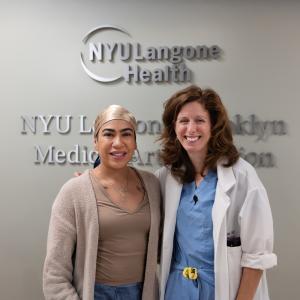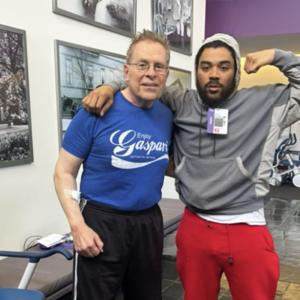
Stroke experts including Dr. Koto Ishida urge people experiencing stroke-like symptoms not to delay care due to COVID-19.
Photo: Karsten Moran
The words “stay home” have resonated with Americans as 2019 coronavirus disease (COVID-19) spreads throughout the country. But when it comes to some life-threatening medical emergencies, including stroke, some are staying home and delaying care—or even avoiding going to the hospital altogether.
“We’ve seen a significant drop in the number of patients coming in for stroke symptoms,” says Shadi Yaghi, MD, assistant professor in the Department of Neurology, research director of the Center for Stroke and Neurovascular Diseases, and director of vascular neurology at NYU Langone Hospital—Brooklyn. “Acute treatment is an important aspect of stroke care that could potentially reverse symptoms and improve a patient’s long-term outcome.”
Separate emergency department (ED) waiting areas, expedited treatment, and faster discharge procedures are all in place across NYU Langone hospitals, ensuring patient safety and effective care during the COVID-19 pandemic.
Time Saved Is Brain Function Saved
Doctors believe that the number of strokes has not decreased, but that people may be postponing treatment because they are afraid of contracting COVID-19, or feel they don’t want to overburden the healthcare system during the pandemic. But getting to the hospital quickly is essential for a person having a stroke—for every minute the brain is deprived of blood due to a blockage, 2 million brain cells are lost. The longer a stroke goes untreated, the greater the potential for brain damage and the less the likelihood of recovery.
Treatments such as clot-busting medication can only be given within four and a half hours of the first symptoms, while advanced clot retrieval and surgical procedures are most effective when they are performed as quickly as possible.
“Some stroke patients are waiting to come to the hospital—they are waiting until it gets really bad or they are forced to come in,” says Koto Ishida, MD, associate professor in the Department of Neurology and medical director of NYU Langone’s Comprehensive Stroke Center and the Center for Stroke and Neurovascular Diseases.
Dr. Ishida recently saw one patient whose symptoms were present for over a week, and only came in after having multiple falls. “At that point, we can do testing to figure out why the stroke happened, try to prevent a future stroke, and provide medications or rehabilitation. But the more emergent therapies and treatment that can really have a big impact of decreasing long-term disability, those are off the table.”
A Focus on Safety
NYU Langone is dedicated to quality and patient safety—earning a Grade A Leapfrog Hospital Safety Grade in 2019 for protecting patients from harm and for providing safer healthcare. The Comprehensive Stroke Center, which operates at both Tisch Hospital and NYU Langone Hospital—Brooklyn, is recognized by both The Joint Commission and New York State Department of Health for providing the most advanced stroke care.
“We are very proactive about protecting patients the best we can from COVID-19,” says David S. Gordon, MD, assistant professor in the Department of Neurosurgery, director of vascular neurosurgery at NYU Langone Hospital—Brooklyn, and a doctor at the Center for Stroke and Neurovascular Diseases. “There are robust protocols in place to maximize the safety of the patients that are coming into the hospital and to keep them isolated from COVID-19 areas to minimize risk.”
There are separate areas of the ED for people who have COVID-19 and patients who do not have the disease. “In the case of stroke, this is such an emergency that those patients will not sit in the ED,” Dr. Gordon says. If a patient comes in by ambulance, the EMTs send a notification even before the patient arrives that lets the stroke care team know their estimated arrival time.
Once a patient is at the hospital treatment begins immediately. “The process is expedited to get them the treatment they need as fast as possible,” says Dr. Yaghi. Stroke neurologists intervene quickly, ordering tests such as brain scans or brain vessel imaging to confirm a stroke diagnosis. They then determine the type of stroke the person is having, which helps doctors decide on the best treatment plan.
“There has been no change in workflow,” Dr. Gordon says. “Our stroke teams and neurosurgical teams continue to be available in full force 24/7 for these emergencies. That attention to emergent patient care has not changed.”
While COVID-19 has not impacted the stroke team’s workflow, it has increased their efficiency at getting patients discharged faster. “There has been a conscious effort to improve our efficiency, even beyond the usual high standards that we strive for,” Dr. Ishida says. “No one is going to stay in the hospital longer than they need to.”
No Replacement for the Emergency Department
Dr. Ishida says that anyone experiencing stroke-like symptoms should call 911 and seek treatment immediately. The acronym FAST—which stands for face, arms, speech, and time—is a quick way to remember the warning signs of a stroke.
“These are symptoms that cannot be managed at home or in an urgent care setting,” says Dr. Ishida. “There is no replacement for the emergency department and the hospital and the advanced imaging capabilities and procedures we have for stroke emergencies—the risk of an untreated stroke is so much higher than catching COVID-19 in the hospital.”

